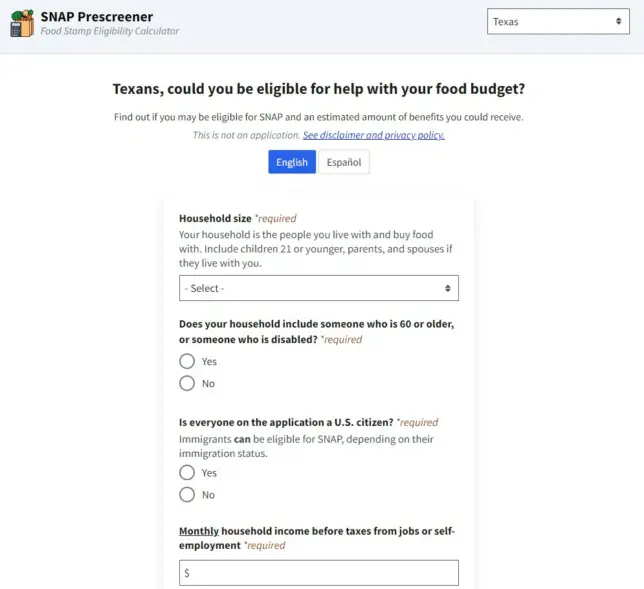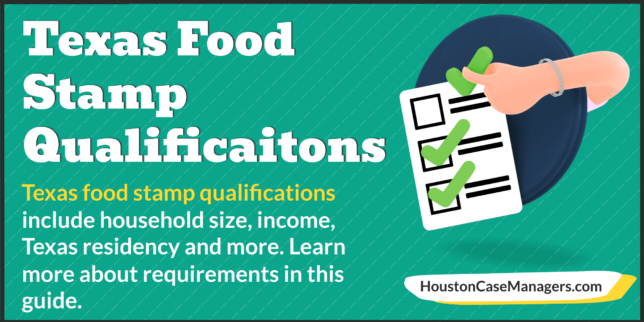Texas Food Stamp Qualifications: Are You Eligible For SNAP Benefits?
In this community resource guide, you will learn about the Texas food stamp qualification.
If you are looking to apply for SNAP benefits in the state of Texas, it is important that you understand the eligibility requirements. Having a basic understanding of who qualifies for food stamps in Texas will help you decide if applying for SNAP is worth your time. If you do not qualify, you certainly don’t want to waste your time completing a food stamp application and gathering the other necessary documents.
The bottom line is if you need food assistance continue reading. We will outline the basic requirements for receiving food stamps in Texas. Keep in mind that these qualifications may vary depending on your individual circumstances.
Who Manages The Food Stamp Program In Texas?
The first step in qualifying for Texas SNAP benefits is understanding who manages the food stamp program. The answer is the Texas Health and Human Services Department.
This is the state agency that you must apply for food stamps in Texas through. They allow you to apply for food stamps via phone, food stamp office, or online.
One thing that you should also know about Texas Health and Human Services is they also manage other supportive services like Medicaid, CHIP, TANF, and more. If you also need health insurance or financial assistance, speak to someone with Texas Health and Human Services at 877.541.7905 to see what government assistance programs you qualify for.
What Are The Texas Food Stamp Qualifications?
The factors that determine whether or not you might meet the SNAP qualifications in Texas include:
- Household size – The number of people who live with you will determine if you meet EBT qualifications in Texas.
- Your monthly household income – The SNAP program has income limits. To meet requirements for food stamps in Texas your income will need to fall under those income limits.
- Any assets you have – This includes your savings, money in your bank account, houses, and cars that you own.
- A resident of Texas – This is straightforward. You need to live in Texas.
- Must be a U.S. citizen or a lawful non-U.S. citizen – In a later section, I will provide you with a list of non-U.S. citizens who can qualify for food stamps.
In the following sections, I will talk more about each factor above. It’s important to understand these factors because the Texas Health and Human Services will use these as a metric to potentially award you with food stamps.
Household Size (Food Stamp Qualifications In Texas)
The number of people who live with you will determine whether you can qualify for Texas SNAP benefits.
The more people in your household that you must feed will increase your chances of getting food stamps. Let’s say you are a single mother who is supporting 3 children. You would be a household of 4. Because you are feeding 4 people, you would need more monthly food stamps than a household of 2 people.
If you had 4 adults who were all working, then your household might not qualify for food stamps. If there are 4 working adults in a home then you would probably exceed the household income requirements. We will talk about household income for the SNAP program in the next section.
Who Is Included In Your Food Stamp Household?
Many people disqualify themselves for food stamps in Texas, because they do not know how to determine who is in their SNAP household. Essentially the people that you should be including on your Texas food stamp application are:
- People who live under the same roof as you. And…
- You share food with those individuals.
If you purchase food for your 3 children, they would be a part of your food stamp household. You would have a household of 4 people.
If your sister recently moved into your home (with you and 3 children) and you did not purchase food for her, then she would not be included in your food stamp household. If someone is living with a family member on a temporary basis and buying their own food and groceries, then they would not be included in your food stamp household.
You can learn more about who you should and should not list on your SNAP application by reading our guide titled Who Is In A Food Stamp Household?
Monthly Household Income (SNAP Qualifications Texas)
Your monthly household income is another factor that determines if you qualify for SNAP benefits. The income limit for food stamps will differ according to the number of people in your food stamp household. For a family of one, you can earn no more than $1,775 per month. The food stamp allowance for a family of three would be limited to no more than $3,020 in income each month.
Below is a table that lets you know what is the maximum household income to qualify for Texas food stamps.
| Household Size | Monthly Income Limit For Texas Food Stamps |
| 1 | $1775 |
| 2 | $2396 |
| 3 | $3020 |
| 4 | $3644 |
| 5 | $4268 |
| Each additional person. | $625 |
Do I Need To Meet Gross Or Net Income Limits To Get Food Stamps In Texas?
Your monthly income will need to fall under both gross and net income. First, you will need to pass the gross income limit and then the net income limit.
To better understand gross and net income limits for SNAP benefits, let’s define both terms.
Gross Income
This is your income before taxes, health insurance, and other deductions are taken out of your paycheck. Gross income is the first income limit test that you will need to pass to qualify for Texas food stamp benefits.
Net Income
The amount of money remaining in your check after taxes, health insurance, and other deductions are subtracted is called net income.
| Deduction | Description |
| Monthly Bills | These monthly bills can potentially be deducted from your : rent, mortgage, water bills, gas bills, utility bills, your phone bill, home insurance, taxes on your home. |
| Dependent Care Costs | The will allow you to deduct things like childcare costs, money spent caring for people in your with disabilities. This also includes senior citizen expenses. |
| Employment/Training Costs | If you are paying tuition or for training programs, this is another cost that you can deduct on the application. |
| The Care Of A Child Outside Your Home | These deductions are things like payments, medical bills, and health insurance that you pay for a child living with an ex-spouse of yours. |
If you pass the gross income limit test for SNAP benefits, your net income (after food stamp deductions have been removed) will need to fall below the required income limits.
How Does SNAP Determine Your Eligibility Based On Gross And Net Income?
Food stamp eligibility is determined when your net income is subtracted from your gross income.
The food stamp program has income requirements for both gross and net income. Here are a few examples to demonstrate how the Supplemental Nutrition Assistance Program decides whether or not you qualify for food stamps.
| Scenario | Description |
| High Gross Income | If your exceeds the for the SNAP program you will not qualify for the . |
| Low | If your falls under the limits, you will now have to meet limits. To meet limits it’s important to list as many deductions as you have. |
| High | If you met limits but failed to meet limits, take a look at your deductions. Have you listed all of your deductions? If not list those deductions to see if this lowers your |
| Low | If your falls under the limits, then you should qualify for food stamps. |
Asset Limit Test (Food Stamp In Texas Eligibility)
An asset limit test looks at the values of things you own like bank accounts, vehicles, and homes and uses this to determine if you qualify for food stamps or not.
You can have a bank account, a home, and even a vehicle, but the value of these assets cannot exceed the asset limit for the Texas SNAP program.
The following is a table that breaks down the asset limits in Texas that you must not exceed in order to qualify for food stamps:
| Asset | Description |
| Cash and Bank Accounts | You must have less than $2,001 or $3,001 in cash, a retirement account, stocks/bonds, or money in your bank account to qualify for stamps in Texas. The amount is based on whether or not you have someone 60 and older or someone with a disability in your home. If you do have one of these individuals the amount is $3,001 that you cannot exceed. |
| Vehicles | You can own a vehicle and receive stamps. The vehicle must have a value of less than $15,000. If you have a second vehicle, that car or truck can be no more than $4,650 in value. |
| Your Home | The will not count your home as an asset, therefore you can own a home and get stamps in Texas. If you own a second home, it will however be subjected to the asset test. |
Must Be A Texas Resident
Another food stamp eligibility requirement is to be a Texas resident.
Must Be A U.S. Citizen Or A Lawful Non-U.S. Citizen To Qualify For Food Stamps
To qualify for SNAP benefits you must be a United States citizen. Undocumented immigrants do not qualify for food stamps, but specific lawful non-U.S. citizens could qualify.
Below is a general list of qualified immigrants who can potentially receive food stamps:
- Lawful permanent residents (those with Green cards) who have lived in the U.S. for 5 years in qualified status. In states like California, Connecticut, Main, Minnesota, and Washington, you do not have to wait 5 years to receive SNAP benefits.
- Refugees accepted by the U.S. who have been given withholding of deportation, conditional entry, or paroled into the country for at least a year.
- Immigrants from Cuba or Hati.
- Battered women and children with a pending or approved 1.) self-petition for an immigrant visa, 2.) an immigrant visa filed for a spouse or child by a U.S. citizen, 3.) an application for cancellation of deportation.
- Victims of trafficking who have obtained the T visa.
- Senior citizens born before August 22, 1931, who lawfully lived in the U.S. on August 22, 1996.
- Lawful permanent residents who have a connection to the U.S. military.
Again, if you are wondering if “undocumented immigrants qualify for food stamps” the answer is no. Outside of U.S. citizens then only people who can qualify for SNAP benefits in Texas are included in the listing above.
Texas Food Stamp Calculator: An Unofficial Tool To See If You Qualify For SNAP Benefits
There is a tool called the Texas food stamp calculator that you can use to see if you might qualify for SNAP benefits. This is not an official tool from Texas Health and Human Services, so even if the calculator stated that you might qualify, you would still need to apply with the state SNAP program.

This tool will however save you time because it can give you a better idea if it’s worth applying for food stamps. The calculator allows you to enter information about your household size, your household income, assets, deductions, age and then states whether you may qualify for the SNAP program.
Conclusion
The Texas food stamp qualifications and requirements can be confusing. This article has aimed to simplify the process by providing explanations of who qualifies for food stamps in Texas and how income and asset limit tests are used to determine eligibility.
Essentially to qualify for food stamps in Texas you must:
- Fall under gross and net income limits.
- Meet income limits for your household size.
- Meet asset limits (bank account, house, car, etc).
- Live in Texas.
- Be a U.S. citizen or a lawful non-U.S. citizen.
Additionally, we’ve included a link to an unofficial Texas food stamp calculator that may help you decide if applying for SNAP benefits is worth your time.
If you have more questions, leave a comment below or simply contact the Texas Health and Human Services Department at 877.541.7905 or visit Your Texas Benefits.
Similar Articles That May Interest You:
- If I Make $1800 A Month Can I Get Food Stamps?
- How To Apply For Emergency Food Stamps In Texas
- 7 Weird Things You Can Buy With Food Stamps
- How To Check Your Food Stamp Status
Nick Bryant is the author of Understanding Healthcare Is Half The Battle and a Senior Counselor with 13+ years of experience working in community health and mental health. He enjoys spending time with his family, watching WWE on Friday nights, and working toward a Google Data Analytics certification. If you have additional questions about community resources or government assistance programs, simply leave a comment below and he will follow up as soon as possible.



